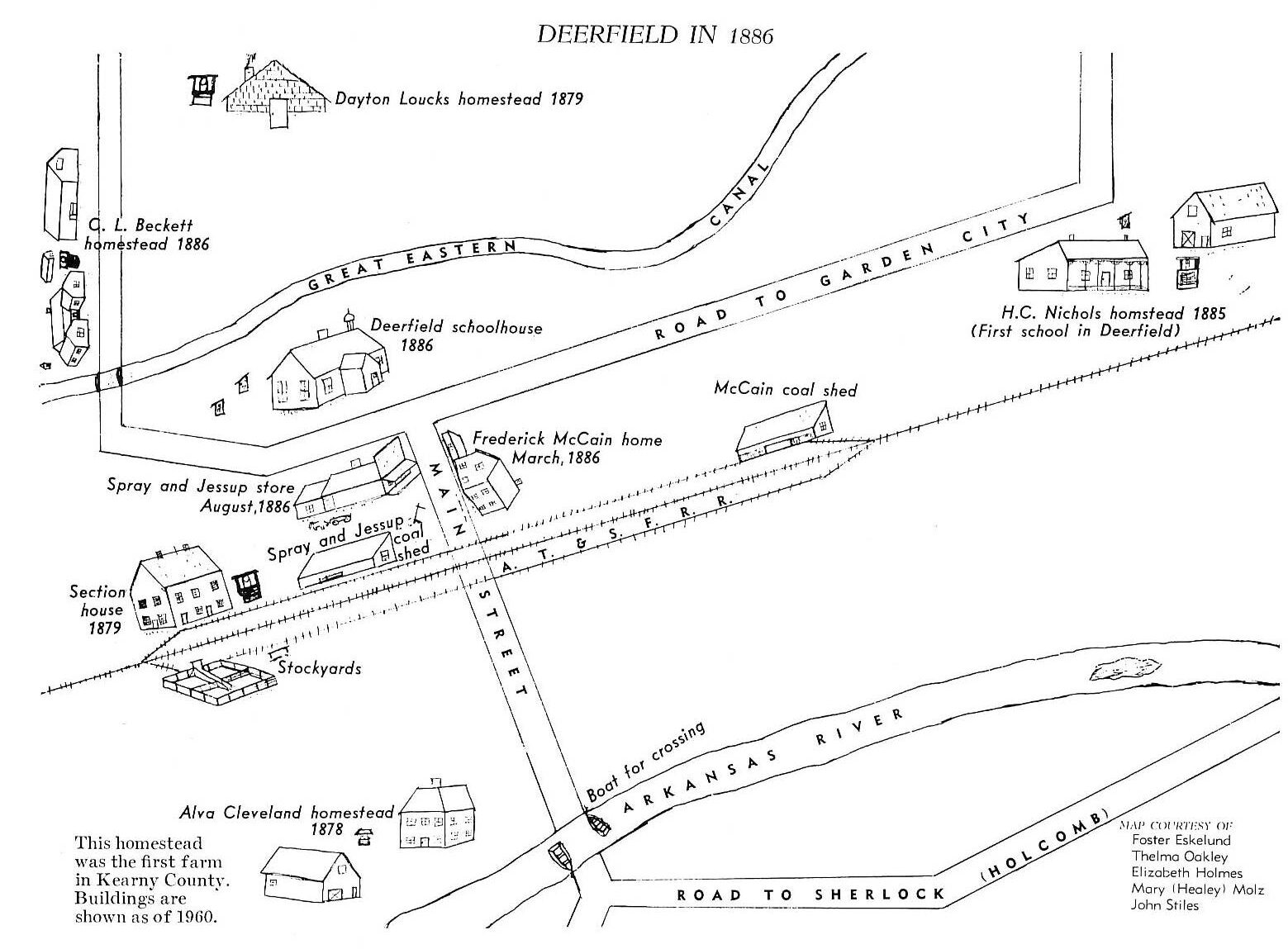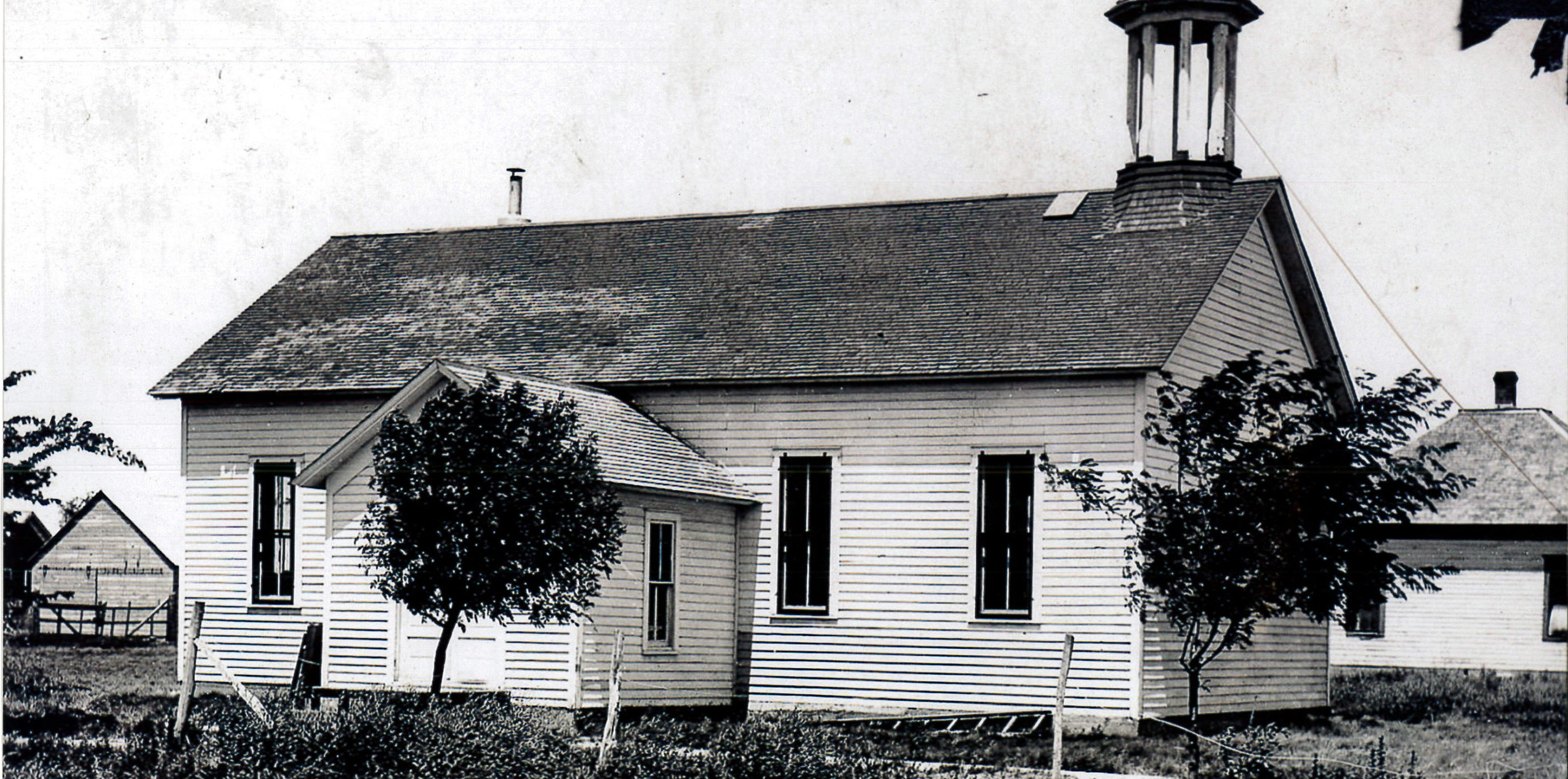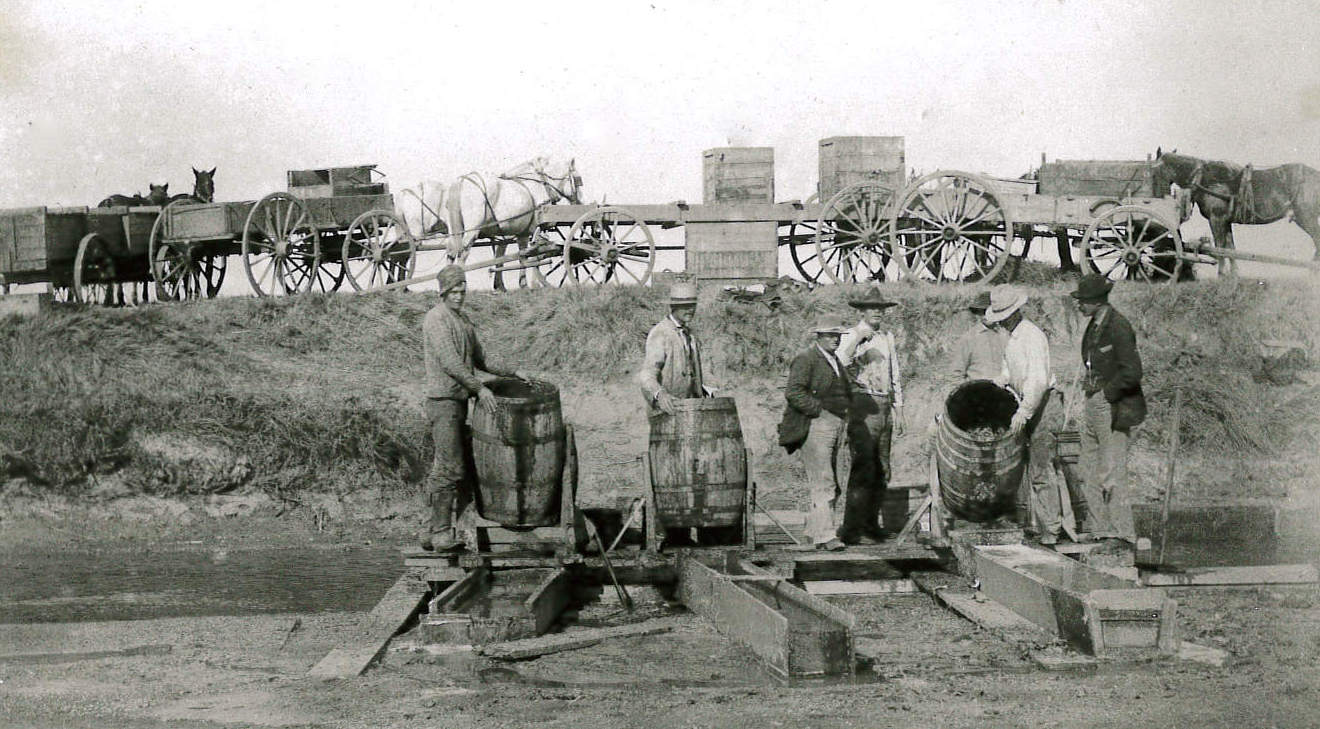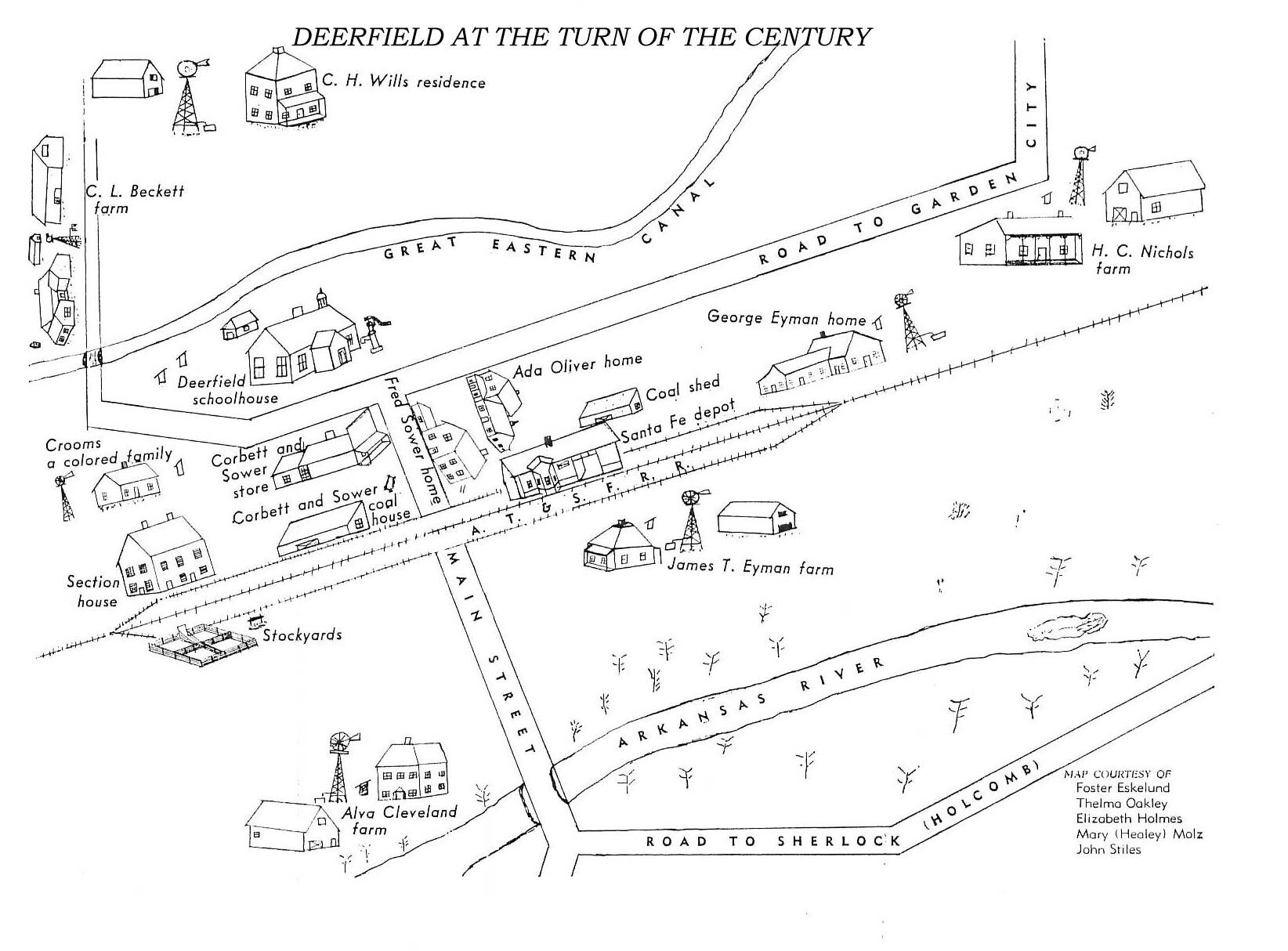How the community of Deerfield was named is a mystery. While some stories attributed the name to a herd of deer that grazed the area, others gave the credit to a Santa Fe Railroad official, and still others claimed the town was named for a community of the same name in Massachusetts. Whatever the case may be, Deerfield’s economy has always relied on agriculture.
Alva Cleveland and his sons Henry and George came to the area in 1878, homesteading the NW ¼ Sec. of 14-24-35. They have the distinction of breaking out the first farmland in Kearny County. Henry became a highly successful farmer, raised horses and cattle, and laid claim to the first chicken and turkey ranch in the county. Apparently, his father and brother went back to Wisconsin, but then Alva joined him here permanently in 1882 along with Henry’s sister, Mary Caswell, and niece, Dolly Caswell.
Brothers William P. and Dayton Loucks came to the Deerfield area in 1879, homesteading Sec. 2-24-35. Dayton stayed at Deerfield and continued to farm his land. William, who had served in the Union Army, moved to Lakin with his wife and two sons when the six months of residence required to establish ownership of the claim was up. He later deeded five acres to Deerfield Township for Deerfield’s cemetery.
Fred Harvey of the Santa Fe Harvey House chain and William Strong, soon-to-be president of the Atchison, Topeka & Santa Fe Railroad, established the XY cattle ranch about 1879 with 10,000 head of cattle. The headquarters were on the north side of the river at Deerfield, but the range was south of the river extending into the Oklahoma Panhandle and Texas. During round-ups, cattle would be rounded up from as far east as Cimarron to the Hartland area. Strong sold his share to Harvey in 1882, and the XY reportedly had 40,000 cattle on the range by 1883. Several men were employed to work the ranch including Samuel Corbett who came to Deerfield in June of 1881. Corbett also started to build up his own ranch, accumulating cattle and running them with the XY’s.
Around 1881, the George Dice family moved from Harvey County and made their home in the newly built railroad section house when George was made section foreman. In March of 1882, the post office was established at the section house, and Belle Dice, George’s wife, was appointed Deerfield’s first postmaster.
The country in and around Deerfield and north to the Wichita-Kearny County line rapidly filled up with homesteaders. Praises for the up-and-coming community were sung in a December 1884 Garden City Sentinel, “Deerfield a small village on the Santa Fe Road fourteen miles west of Garden City, is located in the midst of a fine agricultural district on the North, with magnificent grazing pastures on the South, upon which thousands of cattle are held. Deerfield promises to be a town of considerable importance, Once the country is settled, and her farming resources developed; around her are gathered already men of enterprise who will push her to the front.”
On October 27, 1885, a group of men including Corbett, Dice, W.P. Spray, A.R. Jessup, E.N. Keep, and Frederick McCain filed to locate Deerfield as a village on Sec. 11-24-35. The only house inside the town limits at that time was the section house, but the men believed that Deerfield would eventually rival Lakin.

In March of 1886, McCain established a small store in Deerfield on the ground floor of a story-and-a-half house he built about 100 feet north of the railroad track. The upper story was used for living quarters, and the post office was moved there in November 1886 when McCain was appointed postmaster. McCain also built a small warehouse and coal shed along the spur of the railroad.
In August of 1886, the foundation was put down for Deerfield’s first actual store building which housed the Spray & Jessup Mercantile Co. By December, the Advocate reported an addition being made to this store owing to increasing trade. Deerfield’s first frame school building was also being built at this time. Students began attending in October, but the building was not fully completed and dedicated until February of 1887. The school was then used for Methodist church services and Sunday school.

Township officers called for an election on November 26, 1886 to vote bonds to build a bridge over the Arkansas River for the business and convenience of the people who lived south of the river. The measure passed, and the bridge was completed the following June by Arthur Stayton of Hartland. Previous to the building of the bridge, a man by the name of McFerren was paid to ferry people across the river. By mid-July of 1887, church and Sunday school attendance reportedly doubled due to the new bridge being built.
In an effort to gain votes in the county seat election and help build up the communities of Chantilly and Deerfield, Chantilly founder Carolina Pierce proposed opening a road between the two communities in 1887 for the stage, freight wagons and other travel. In August of 1887, the Sentinel reported that the stagecoach was carrying many passengers on the diagonal road to Chantilly, and Deerfield was booming in a quiet, sure way. Although the stage line operated nearly every day through most of 1887 and 1888, when Chantilly faded away so did the line.
On September 1, 1888, a petition was signed by the people of Deerfield and surrounding vicinity asking that a depot be located there. After a tour of investigation, the railroad commissioner reported very favorably for the community, stating that the A.T. & S.F. could acquire more business owing to the large amount of crops that could be grown in the area due to irrigation. Still, the people of Deerfield had to wait. The Index reported that Deerfield’s depot was not completed until July of 1891, and Miss Ada Oliver was installed as agent.

There was little change as to population or people in the Deerfield area during the 1890s. Most irrigation farmers were raising immense vine crops such as watermelon, squash, muskmelon, pumpkin and cucumber for seed. In the mornings during melon season, the road would be lined with as many as 25 to 50 wagons loaded with barrels of melon on their way to the Arkansas River to wash seeds. A considerable amount of alfalfa, sorghum and some wheat and corn were also raised. Although rural Deerfield was considerably populated, the village of Deerfield had not changed much by 1900, but things were about to change in a big way with the introduction of sugar beets to the area.

SOURCES: Most of this information was provided by the late Foster Eskelund for History of Kearny County Vols. I and II; A Standard History of Kansas and Kansans Vol. IV by William E. Connelley; Annual reports of the Atchison, Topeka and Santa Fe Railroad; archives of The Advocate, Lakin Independent, Lakin Index, Topeka Daily Capital, Newton Kansan, Garden City Herald, Garden City Irrigator, and Garden City Sentinel; Ancestry.com; Museum archives.
